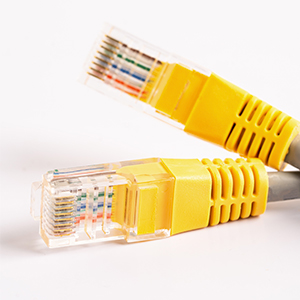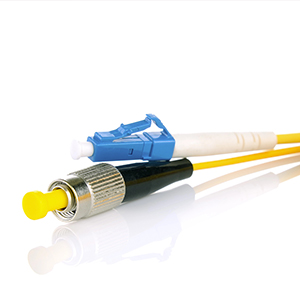While low voltage cabling may not be as glamorous as granite countertops, it’s a vital component in internet connectivity, TV service, HVAC systems, future IoT capabilities, and so much more, and it fundamentally impacts your residents’ experience across your entire property. For this reason, it pays for property owners and property management companies to stay up to date on the best practices in cabling infrastructure.
In the following guide, we’ll take you through a comprehensive overview of the types of cabling and wiring designs that are popular in modern properties. We’ll also show you how to assess whether a retrofit is necessary — and help you inspect your property’s existing cabling infrastructure to make that determination. With this knowledge, you’ll be able to make informed decisions to ensure your properties are well-equipped to meet both current and future technological demands.
But First, What Is Low Voltage Cabling?
Otherwise known as structured cabling, low voltage cabling is used for systems that require less power, such as internet, telephone, security, and audiovisual systems.
Low voltage cabling vs. high voltage cabling
What’s the difference between low voltage wire and regular wire? Low voltage wire is designed for lower power applications, typically less than 50 volts. It’s often thinner and more flexible than regular wire, which is used for standard electrical power distribution and is rated for higher voltages.
What is the standard for low voltage wiring?
The National Electrical Code (NEC) and the Telecommunications Industry Association (TIA) set standards for low voltage wiring, such as NEC Article 725 and TIA/EIA-568.
What kind of wire do you use for low voltage?
Common types of low voltage wire include coaxial cable, Category (Cat) cables like Cat5e and Cat6, coaxial cable, and fiber.

The Importance of Wiring in Multifamily Properties
“It’s hard to overstate the importance of low voltage cabling,” says Dustin Johnston, Vice President of MDU Sales at MDU Internet Services.
Today, modern cable infrastructure is recognized as one of the most critical assets for properties. Many owners have learned the hard way — just five years ago, they were advised by cable companies that fiber or Ethernet weren’t necessary. As a result, properties were commonly set on the wrong path. And that’s unfortunate, as the cost of rewiring is ten times higher than installing it correctly the first time.
Types of Low Voltage Cabling
 • Coaxial cable, or “coax cable,” consists of a central conductor, an insulating layer, a metallic shield, and an outer insulating layer. Examples of coaxial cable include RG6, RG59, and RG11.
• Coaxial cable, or “coax cable,” consists of a central conductor, an insulating layer, a metallic shield, and an outer insulating layer. Examples of coaxial cable include RG6, RG59, and RG11.
 • Ethernet cable consists of four twisted pairs of copper wires encased in a plastic sheath. Examples include Cat5, Cat5e, Cat6, Cat6a, Cat7, and Cat8 with the higher categories providing better performance.
• Ethernet cable consists of four twisted pairs of copper wires encased in a plastic sheath. Examples include Cat5, Cat5e, Cat6, Cat6a, Cat7, and Cat8 with the higher categories providing better performance.
Is Cat6 considered low voltage?
Ethernet cables like Cat5 and Cat6 are considered low voltage as they require less power than standard electrical wiring for data transmission and networking.

• Fiber optic cables are quite literally the backbone of modern telecommunications and networking. With their high bandwidth and long-distance capabilities for high-speed data transmission, they’re considered the gold standard today.
Categories include:
-
- Single-Mode Fiber (SMF) for long-distance telecommunications, high-speed data networks, and internet backbone infrastructure
- Multi-Mode Fiber (MMF) for short-distance communication (inside buildings or data centers, for example)
If your property is 10 years or older, or a major cable provider provided your wiring, it’s likely your property has coax installed.
Coax, Dustin explains, is a technology that has been used for more than 100 years and is still the go-to for modern cable TV. However, its capabilities and benefits pale in comparison to those of Cat6 and fiber (to the unit), which are now standard in the newest properties.
“With coax, the best speed you’ll generally see is 1 Gig [Gbps, or Gigabits per second] down and 35 Mbps [Megabits per second] up to the unit, whereas right now clients need at least 1 Gig up and down and are already requesting speeds of 2.5 Gigs and up to the unit — which is only doable through a fiber to the unit (FTTU) design.”
To give an idea of its capabilities, fiber to the unit can handle up to 100 Gbps for the resident, depending on the equipment.
“This extra capacity is crucial. In the next 10 years, without an upgrade, coax cabling will be significantly limited. With fiber, your property is likely to be future-proof for the next 40 years,” Dustin explains. “You’ll only need to upgrade the equipment along the way to keep up with evolving standards.”
During heavy-duty renovation projects that require units to be unoccupied, it’s an ideal time to upgrade cabling infrastructure. This is because it eliminates the auxiliary costs and logistical challenges typically associated with rewires, such as relocating residents temporarily or working around their schedules.
Another consideration is ownership, Dustin says. “In a lot of cases, owners don’t own the wiring at the property. It actually belongs to the cable company that installed it. And while in 1993 the FCC started prohibiting certain types of exclusive wiring agreements, it wasn’t until 2022 that “sale and leaseback” arrangements were required, which essentially allow the owner to have a “buy-out” when they’re ready to move away from their local cable provider.”
Owning the wiring infrastructure offers long-term benefits like being able to control and adapt the network infrastructure as needed. “If you’re investing in fiber or Cat6, you own the wiring, and you can change who can transmit over the cabling anytime you want.”
Additionally, when you sell the property, you’ll be able to leverage the wiring as an asset. While the cost of rewiring a property can be anywhere from $50,000 to $200,000, it significantly increases the property’s value, which will be reflected in your property valuation.
Low Voltage Cable Installation: What Are Your Options?
When upgrading your low voltage cabling, properties have two main contractor options: 1) a telecommunications service provider such as Comcast or Verizon, or 2) a managed services provider (MSP), which offers end-to-end solutions including design, installation, and management of the network.
While a telecom provider may install the cable for you at no cost, they will own it in perpetuity, or at least until you decide it’s time to finally pay for the old wiring years down the road. In contrast, a managed service provider will install and maintain the cabling infrastructure, providing you with an asset you can utilize.
Looking to Rewire? Follow These Steps
Thinking about upgrading your property’s cabling infrastructure? Here’s how to get started:
1. Identify your current cabling infrastructure
A key question is whether or not you have what’s known as a “fiber backbone.”
“If you’re going to be remodeling your property, it’s definitely worth considering upgrading your coax cabling to fiber or Cat6A,” recommends Dustin.
Picture a tree: the fiber backbone serves as the trunk, with three different branch options leading to the units, each determining data transfer speed and bandwidth:
-
- Coax cable: Supports 1 Gbps to the unit.
- Cat6A cable: Supports 10 Gbps to the unit.
- Fiber cable: Supports up to 100 Gbps per unit.
If you have a fiber backbone, you’ll know you can get 1 Gbps over coax cable.
And whether or not you have a fiber backbone, if your distribution cable is coax, the highest speed you could get is 1000 Mbps, or 1 Gbps. “You’re going to be capped at the slowest point,” says Dustin.
How to find out your current cabling:
Check the wiring in your telecommunications room. It will be clearly labeled. You can compare what you have to the pictures above. Alternatively, maintenance staff or your current cable provider can also confirm what type of cabling you have.
2. Install a fiber backbone if none exists
“I would replace the coax with a fiber backbone in every case,” Dustin advises. “That’s going to take you halfway to getting the speed and reliability your residents expect now and will want in the future.”
Installing a fiber backbone costs much less than rewiring every unit, as it doesn’t require residents to move out. “It can be done without ever going inside residents’ units, which means there are no disruptions to their lives,” says Dustin.
3. Work with a multifamily internet consultant to determine the best wiring design
The wiring design you select will depend on your property’s needs and your budget.
-
- New builds:
The standard wiring design for new build apartment complexes preferred by most of the largest management companies is “two Cat6 home runs to the unit.” This means there are two runs of cable running directly into every unit.
- New builds:
One of those runs goes to the main networking device, which could be an access point with managed service providers or, in the case of a cable company, a modem/router.
The second run goes to a central distribution point within the unit, such as a patch panel or network switch in a closet. From there, the network connection is distributed to each room and the living room. In the case of a four-bedroom apartment, for example, the signal is distributed five times — one run for each of the four bedrooms plus one for the living room.
-
- Retrofits:
For brownfields or retrofit projects, the wiring design often leverages existing infrastructure to minimize disruption and costs, and it can vary widely from property to property.
- Retrofits:
Fiber installations
In the multifamily space, we typically see the following distribution of wiring designs:
-
- Upper-tier properties: Install fiber to the units (fiber everywhere)
- Middle-tier properties: Opt for a fiber backbone along with the design mentioned above (two Cat6 home runs to the unit)
- Lower-tier properties: Use a fiber backbone with just one Cat6 home run to the end device (access point or modem/router)
While multifamily properties may be able to “get by” with less optimal designs, they run the risk of poor reliability, deterioration of signal quality, and slower speeds, especially as technologies continue to advance and demands grow for higher bandwidth.
“If you’re not installing a wire run to each bedroom, you’re going to have angry residents,” Dustin says.
Take remote workers, for instance, who need to be plugged into a wired port to achieve the best speeds. Without hardwiring their laptop in, the best speed possible is 10 Mbps. For gamers, this becomes even more critical. They’ll experience higher latency, higher ping (response rates between two different devices), and slower speeds, all because they can’t directly connect their devices.
Multifamily Low Voltage Cabling Experts
If you want to make sure your property maintains high occupancy rates, it’s important to prioritize modern, reliable cabling infrastructure. The right low voltage cabling can significantly impact the performance and reliability of your internet and other systems, enhancing your property’s appeal and value to both residents and future buyers.
Ready to elevate your property’s network? Contact MDU Internet Services Today for a free consultation. We can help you determine your current wiring infrastructure, assess your property’s current needs, and recommend cost-effective solutions for both new builds and retrofits to meet your residents’ needs and your budget.

